Jamaican Flag, Anthem & Symbols
Learn about the National Flag of Jamaica, the National Anthem of Jamaica and other National Symbols of Jamaica
- The National Flag of Jamaica
- The National Anthem of Jamaica
- The Jamaican Coat of Arms & National Motto
- The National Bird: The 'Doctor Bird' or Swallow-Tail Hummingbird
- The National Flower: The Lignum Vitae
- The National Fruit: The Ackee
- The National Tree: The Blue Mahoe
The National Flag of Jamaica
The National Flag of Jamaica

The National Flag of Jamaica is comprised of a gold saltire (or diagonal cross) with the triangular areas above and below in emerald green and the flanks in black. The flag is twice as wide as it is high and the gold saltire is one sixth the height of the flag.
The National Flag was first used on 6 August 1962, the date Jamaica gained independence from the British-protected Federation of the West Indies. It is one of only two current national flags in the world that do not feature any of the colours red, white, or blue (the other being Mauritania).
The use of the saltire has been said to hint of the Irish and Scottish roots of some of Jamaica's population as the flags of Saint Andew and Saint Patrick both use the saltire.
[Historical note: When the 1800 Act of Union joined the Kingdom of Ireland with the Kingdom of Great Britain, the saltire of Saint Patrick was added to the British flag to form the Union Flag still used today by the United Kingdom].
The bipartisan committee of the Jamaica House of Representatives that initially chose the flag in 1962 described its symbolism as follows: "Black stands for hardships overcome and to be faced; gold for the natural wealth and beauty of sunlight and green for hope and agricultural resources". Over the years this interpretation was criticised with the equation of "hardship" with the colour black especially since the Island's population is predominantly black. In 1997 a committee of the House of Representatives re-examined the country's national symbols and concluded that flag should be interpreted as "the sun shineth, the land is green and the people are strong and creative".
Back to TopThe Jamaican National Anthem
The National Anthem of Jamaica
The National Anthem of Jamaica, Jamaica, Land We Love was chosen by a Joint Committee of the Houses of Parliament following a competition held in the run-up to Jamaica securing independence from the United Kingdom (UK). The Anthem is the creative work of four persons, the late Rev. and Hon. Hugh Sherlock, OJ, OBE, the late Hon. Robert Lightbourne, OJ, the late Mapletoft Poulle and Mrs. Poulle (now Mrs. Raymond Lindo).
On 6 August 1962 Jamaica, Land We Love officially became the National Anthem of Jamaica replacing "God Save the Queen".
Verse 1 |
Verse 2 |
|
Eternal Father bless our land, Guard us with Thy Mighty Hand, Keep us free from evil powers, Be our light through countless hours. To our Leaders, Great Defender, Grant true wisdom from above. Justice, Truth be ours forever, Jamaica, Land we love. Jamaica, Jamaica, Jamaica land we love. |
Teach us true respect for all, Stir response to duty’s call, Give us vision lest we perish. strengthen us the weak to cherish, Knowledge send us Heavenly Father, Grant true wisdom from above. Justice, Truth be ours forever, Jamaica, land we love. Jamaica, Jamaica, Jamaica land we love. |
The Jamaican Coat of Arms & National Motto
The Jamaican Coat of Arms & National Motto
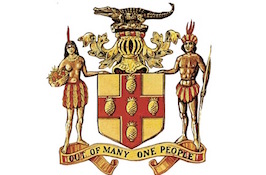
The Jamaican Coat of Arms comprises a shield bearing a red cross with five golden pineapples which is flanked on either side by a female and male Taino Indian. The crest is a Jamaican crocodile mounted on the Royal Helmet and mantling of the British Monarchy. The National Motto - "Out of Many, One People" - which was adopted at the time of Jamaica's Independence, appears below the shield.
The original Jamaican coat of arms was granted to Jamaica in 1661 under Royal Warrant and was designed by William Sancroft, then Archbishop of Canterbury. Prior to Jamaica securing independence in 1962, the Coat of Arms reflected the Latin motto "INDUS UTERQUE SERVIET UNI" meaning "The two Indians will serve as one" in reference to the collective servitude of the Taino and Arawak Indians to the British colonisers of Jamaica. This motto was replaced in 1962 with the English motto "Out of Many, One People",as tribute to the unity of the different ethnic and cultural groups inhabiting Jamaica.
Back to Top
The National Bird: The Swallow-Tail Hummingbird
The National Bird: The Swallow-Tail Hummingbird
 The 'Doctor Bird' or Swallow-Tail Hummingbird (Trochilus Polytmus), is one of the most outstanding of the 320 species of hummingbirds. It lives only in Jamaica.
The 'Doctor Bird' or Swallow-Tail Hummingbird (Trochilus Polytmus), is one of the most outstanding of the 320 species of hummingbirds. It lives only in Jamaica.
These birds’ beautiful feathers have no counterpart in the entire bird population and they produce iridescent colours characterstic only of that family. In addition to these beautiful feathers, the mature male has two long tails which stream behind him when he flies. For years the doctor bird has been immortalized in Jamaican folklore and song.
The origin of the name ‘Doctor-bird’ is somewhat unsettled. It has been said that the name was given because the erect black crest and tails resemble the top hat and long tail coats doctors used to wear in the old days. Other schools of thought believe that it refers to the way the birds lance the flowers with their bills to extract nectar.
In Jamaican folklore, the bird is an object of superstition.The Arawaks spread the belief that the bird had magical powers. They called it the ‘God bird’, believing it was the reincarnation of dead souls. This is manifested in a folk song which says: “Doctor Bud a cunny bud, hard bud fe dead”. (It is a clever bird which cannot be easily killed).
Back to TopThe National Flower: Lignum Vitae
The National Flower: Lignum Vitae
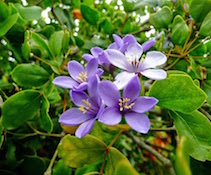 The Lignum Vitae (Guiacum Officinale) is short, compact tree native to the Caribbean and the northern coast of South America. In Jamaica, it grows best in the dry woodland along the north and south coasts of the island.
The Lignum Vitae (Guiacum Officinale) is short, compact tree native to the Caribbean and the northern coast of South America. In Jamaica, it grows best in the dry woodland along the north and south coasts of the island.
The plant is highly ornamental, producing an attractive blue flower and orange-yellow fruit, while its crown has an attractive rounded shape. In addition to being the National Flower of Jamaica, the Lignum Vitae is the National Tree of The Bahamas.
The body, gum, bark, fruit, leaves and blossom all serve some useful purpose. Lignum Vitae, when translated from Latin, means “wood of life” – probably adopted because of its medicinal qualities. A gum (gum guaiac) obtained from its resin was once regarded as a purgative. It was exported to Europe from the early sixteenth century as a remedy (combined with mercury) for syphillis and has also been used as a remedy for gout.
Lignum Vitae is hard and durable and is also the most dense traded wood: it easily sinks in water. On the Janka Scale of Hardness, which measures hardness of woods, Lignum Vitae ranks highest of the traded woods. It has been used as propellor shaft bearings in conventional ships and hydroelectric plants: indeed the aft main shaft strut bearings of the USS Nautilus, the world's first nuclear-powered submarine, are made from Lignum Vitae. In addition to being strong, hard, heavy, dense, water- and salt-water-resistant, Lignum Vitae contains natural oils that make the bearings self-lubricating.
The Master clockmaker John Harrison used Lignum Vitae in the bearings and gears of his pendulum clocks and his first three marine chronometers: The use of Lignum Vitae eliminated the need for horological lubricating oil; 18th-century horological oil would get gummy and reduce the accuracy of a timepiece under unfavourable conditions (including those that prevail at sea). Lignum Vitae is also used for items such as mortars, mallets, pulleys and police batons.
Back to TopThe National Fruit: The Ackee
The National Fruit: The Ackee
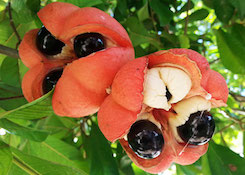 Ackee (Blighia sapida) is the National Fruit of Jamaica as well as a component of the national dish – ackee &saltfish (i.e. salted codfish). It is a very delicious fruit and when boiled and cooked with seasoning and salt fish or salt pork, it is considered one of Jamaica’s greatest delicacies.
Ackee (Blighia sapida) is the National Fruit of Jamaica as well as a component of the national dish – ackee &saltfish (i.e. salted codfish). It is a very delicious fruit and when boiled and cooked with seasoning and salt fish or salt pork, it is considered one of Jamaica’s greatest delicacies.
Ackee is not however indigenous to Jamaica. Originally, it was imported to the island from West Africa, probably on a slave ship. Now it grows here luxuriantly, producing large quantities of edible fruit each year.
The ackee tree grows up to 50 feet tall under favourable conditions. It bears large red and yellow fruit which, when ripe, burst into sections revealing shiny black round seeds on top of a yellow aril which is partially edible.
There are two main types of ackee identified by the colour of the aril. That with a soft yellow aril is known as ‘butter’ and ‘cheese’ is hard and cream-coloured. Ackee contains a poison (hypoglcin) which is dissipated when it is properly harvested and cooked. The fruit should not be gathered until the pods open naturally. In addition, the aril must be properly cleaned of red fibre and the cooking water discarded.
Ackee is derived from the original name 'Ankye' which comes from the Twi language of Ghana. The botanical name of the fruit – Blighia Sapida – was given in honour of Captain William Bligh of “Mutiny on the Bounty” fame, who in 1793 took plants of the fruit from Jamaica to England. Captain Bligh also brought the first breadfruit to Jamaica. Before this, the ackee was unknown to science. In 1778, Dr. Thomas Clarke, one of the earliest propagators of the ackee tree, introduced it to the eastern parishes of the Island.
 Jamaica is the only place where the fruit is widely eaten. It has however been introduced into most of the other Caribbean islands (for example, Trinidad, Grenada, Antigua and Barbados), Central America and Florida, where it is known by different names and does not thrive in economic quantities. Jamaican canned ackee is now exported and sold in markets patronised by the Jamaican diaspora.
Jamaica is the only place where the fruit is widely eaten. It has however been introduced into most of the other Caribbean islands (for example, Trinidad, Grenada, Antigua and Barbados), Central America and Florida, where it is known by different names and does not thrive in economic quantities. Jamaican canned ackee is now exported and sold in markets patronised by the Jamaican diaspora.
The National Tree: The Blue Mahoe
The National Tree: The Blue Mahoe
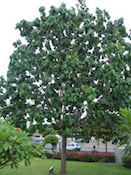 The Blue Mahoe (Hibiscus Elatus) is the national tree of Jamaica. It is indigenous to the island and grows quite rapidly, often attaining 60 feet or more in height. In wetter districts it will grow in a wide range of elevations, up to 4000 feet and is often used in reforestation.
The Blue Mahoe (Hibiscus Elatus) is the national tree of Jamaica. It is indigenous to the island and grows quite rapidly, often attaining 60 feet or more in height. In wetter districts it will grow in a wide range of elevations, up to 4000 feet and is often used in reforestation.
The tree is quite attractive with its straight trunk, broad green leaves and hibiscus-like flowers. The attractive flower changes colour as it matures, going from bright yellow to orange red and finally to crimson.
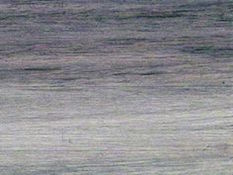 The name mahoe is derived from a Carib Indian word. The ‘blue’ refers to blue-green streaks in the polished wood, giving it a distinctive appearance. The Blue Mahoe is so beautiful and durable that it is widely used for cabinet making and also for making decorative objects such as picture frames, bowls and carving.
The name mahoe is derived from a Carib Indian word. The ‘blue’ refers to blue-green streaks in the polished wood, giving it a distinctive appearance. The Blue Mahoe is so beautiful and durable that it is widely used for cabinet making and also for making decorative objects such as picture frames, bowls and carving.
The inner bark of the tree is often referred to as ‘Cuba bark’ because it was formerly used for tying bundles of Havana cigars. Cuba is the only other place where the Blue Mahoe grows naturally.
Back to Top